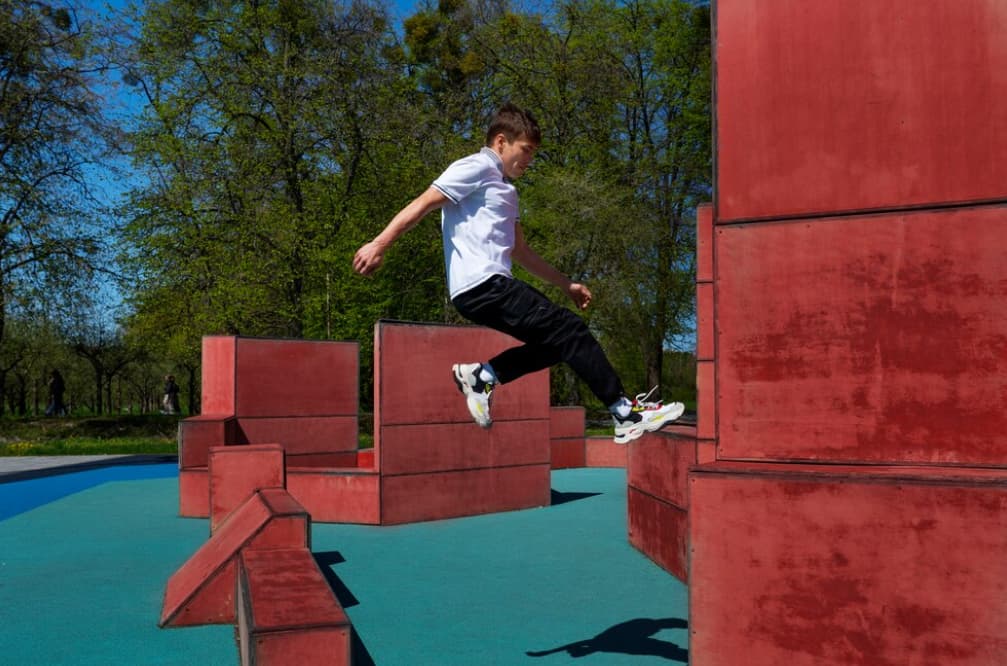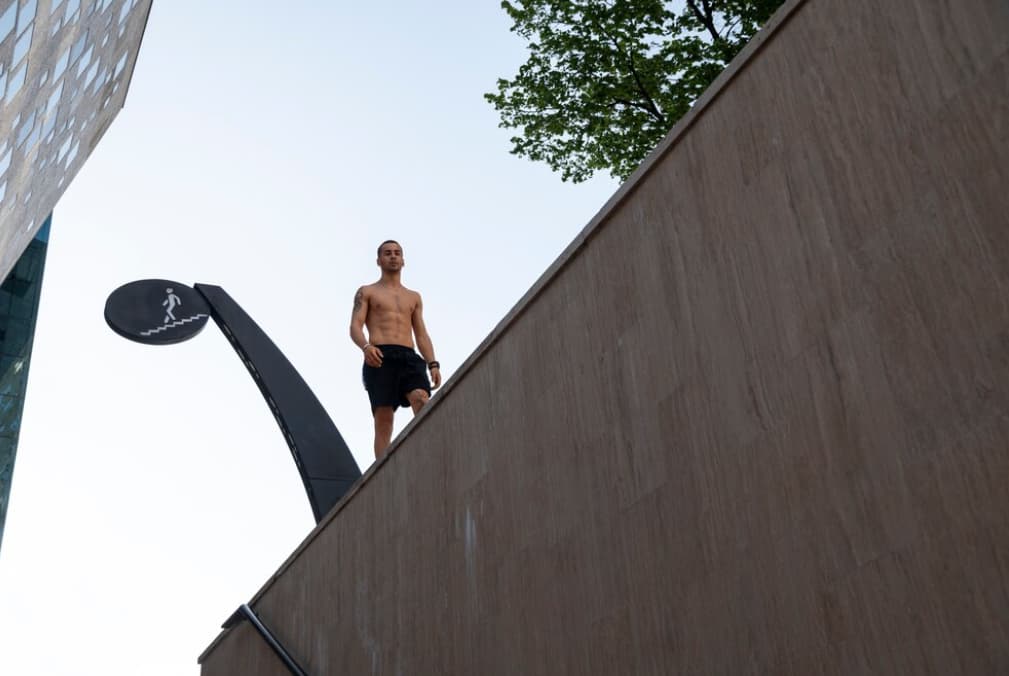Parkour, also referred to as free-running, is an athletic discipline where practitioners navigate through environments by vaulting, rolling, running, climbing, and leaping, using urban landscapes as their obstacle courses. It’s a deliberate and strategic method of movement, crafted with intention and purpose, rather than aimless physical exertion.
More than mere physical exercise, parkour is a mental practice that hones the ability to identify opportunities in seemingly impassable spaces. It’s this blend of mental and physical agility that draws numerous enthusiasts to the sport, eager to master the art of efficient movement and overcome the challenging, often breathtaking stunts involved in becoming adept free runners.
If you’re interested in improving your parkour skills, you may also like our article on ‘How to Jump Higher Instantly‘, which offers practical tips to boost your jumping ability, a crucial aspect of parkour.
Getting Started with Parkour: Tips for Beginners
Interested in pursuing parkour training? While the desire is commendable, becoming a skilled parkour practitioner doesn’t happen overnight. It involves a learning process that all parkour athletes must go through, and it’s essential to begin at the foundation. Here’s a guide on how to get started:
Preparing Your Mind for Parkour Success
Preparing your mind is all about clearing it of any preconceptions or self-doubt that might hinder your progress, making it receptive to new learning experiences. This involves letting go of any preconceived notions about parkour and your current level of fitness.
Even if you’re a skilled gymnast with great flexibility, adapting to parkour can be challenging because it operates by different principles. To thrive as a beginner, consider the following:
- Embrace your inner curiosity and cultivate a deep desire for exploration;
- Have confidence in your abilities while recognizing your limits. Parkour may be daring, but approach it with reasonable caution to avoid accidents;
- Prioritize safety at all times. While some traditional sporting safety rules may not directly apply to parkour, following them is a wise practice. It’s better to be safe and avoid setbacks caused by injuries.

Getting Physically Prepared for Parkour
A strong and determined mindset is crucial for learning parkour, but without a physically fit body, progress may be limited. Therefore, it’s essential to get in shape. Note that this doesn’t necessarily mean shedding a specific amount of weight; rather, it’s about building endurance.
To improve your fitness for parkour, consider incorporating basic calisthenics exercises into your routine, such as push-ups, pull-ups, sit-ups, and squats. As a beginner, aim to achieve the following as a starting point:
- About 25 push-ups;
- Five pull-ups;
- 50 squats.
These exercises will lay the foundation for your physical preparation in parkour, helping you make meaningful progress.
The Importance of Balance in Parkour Training
In contrast to most sports found on csgo-betting sites, where balancing skills are often irrelevant, parkour stands out as a discipline that places a premium on balance. Achieving and mastering balance is absolutely essential for those who aspire to become proficient parkour athletes.
- Whether you’re navigating a narrow rail or traversing a thin wall, the ability to maintain your balance is paramount in preventing potentially injurious falls;
- To develop this critical skill, it’s essential to cultivate a focused mindset, remain fully engaged in the present moment, minimize distractions, and take deliberate, calculated steps;
- Start with the basics, such as walking a straight line on a road, and progressively challenge yourself by moving on to ridges and walls;
- Building a strong foundation in balance is a crucial step on your journey to becoming a skilled parkour practitioner.
Perfecting Parkour Safety: Shoulder Rolls and Landings
In the realm of parkour, mastering the techniques of rolling and landing is of paramount importance for any aspiring athlete. Any misstep in these maneuvers can lead to dislocations and, in severe cases, even fractures.
Parkour is characterized by numerous vertical movements and high jumps, which demand precision and safety. As a beginner, it’s vital to exercise caution and avoid overextending yourself in a bid to be daring. Instead, take gradual steps in your training.
- Begin by honing your ability to perform effective rolls without causing harm;
- Practice rolling techniques meticulously before attempting more complex moves;
- When it comes to jumps, start with heights ranging from ½ meter to 1 meter, ensuring you land on the balls of your feet with your knees bent to absorb the impact;
- For higher jumps, incorporate a forward roll after landing, utilizing your shoulders to cushion the impact rather than relying on your back;
- Prioritizing these safety measures will not only enhance your skills but also safeguard your well-being in the dynamic world of parkour.
Vaulting, Jumping, and Climbing Techniques
Starting with vaulting is essential for beginners in parkour to navigate safely over barriers like rails or blockades. You can begin with two fundamental techniques: the parkour turn vault and the parkour safety vault.
Both techniques necessitate using your hands, and even a small error can lead to injuries like fractures. Therefore, it’s crucial to always engage both hands for maximum strength and thoroughly practice these vaults before attempting to increase distance or add complexity.
In addition to vaulting, jumping and climbing are key skills in parkour for overcoming obstacles, particularly in urban environments. While there are numerous techniques in these areas, it’s advisable to first become proficient in the basic moves before progressing to more advanced variations.
Learning the Basics of Wall Run/Tic-Tac in Parkour
- The wall run/tic-tac is often the most anticipated technique for those eager to start parkour, particularly for fans of action films. This move, which gives a sensation of defying gravity, requires a gradual approach to avoid rushing into it too quickly;
- As with other parkour skills, it’s important to start slowly. Begin with practicing a single step, then progress to three, and gradually increase to four and more. Parkourshoesguide suggests a focus on understanding your body’s movement trajectory. It’s also recommended to wear parkour shoes with extra grip and to ensure a strong run-up and firm grip while performing this technique.

Cultivating a Unique Parkour Style
Social media platforms are filled with videos of parkour athletes performing breathtaking stunts with apparent ease and enjoyment. While watching these videos is both entertaining and informative, it’s important to observe that each athlete exhibits a distinct personal style.
Developing a personal style in parkour involves refining a specific and clear approach to how you position your body when tackling obstacles. It’s essential to remember that what works for one individual may not suit another. Therefore, focus on creating a style that aligns with your body type and personal goals in parkour.
Setting Boundaries in Parkour Training
If you’re just starting out as a parkour athlete, you’re in the process of mastering the sport’s techniques, building your endurance, and developing your unique style. It’s crucial not to push yourself too hard right from the beginning. Instead, focus on selecting both a starting and finishing point for your training sessions. Commit to doing whatever it takes to reach that specific goal, and ensure that you stay within those limits. This approach will help you progress safely and effectively in the world of parkour.
Enhance Your Progress with a Coach and Group Training
Achieving your goals becomes significantly more manageable when you have a supportive companion and an encouraging voice beside you. Once you’ve completed the initial steps independently, consider enlisting the guidance of a coach and participating in group training to take your skills to the next level. This approach guarantees that you’ll have a team of individuals watching over your progress, providing guidance, and ensuring that you maintain a healthy balance without pushing yourself too hard.
Conclusion
Embarking on a parkour journey is not just an opportunity to learn a thrilling sport; it’s also a profound mental and physical experience. Keep in mind that it’s not about the risky stunts or the high jumps, but the ability to view your surroundings in new and exciting ways. The journey might seem lengthy and daunting at first, but with patience, perseverance, and proper guidance, you’ll be mastering parkour techniques in no time. Remember to listen to your body, know your limits, and most importantly, enjoy the adventure that is parkour.